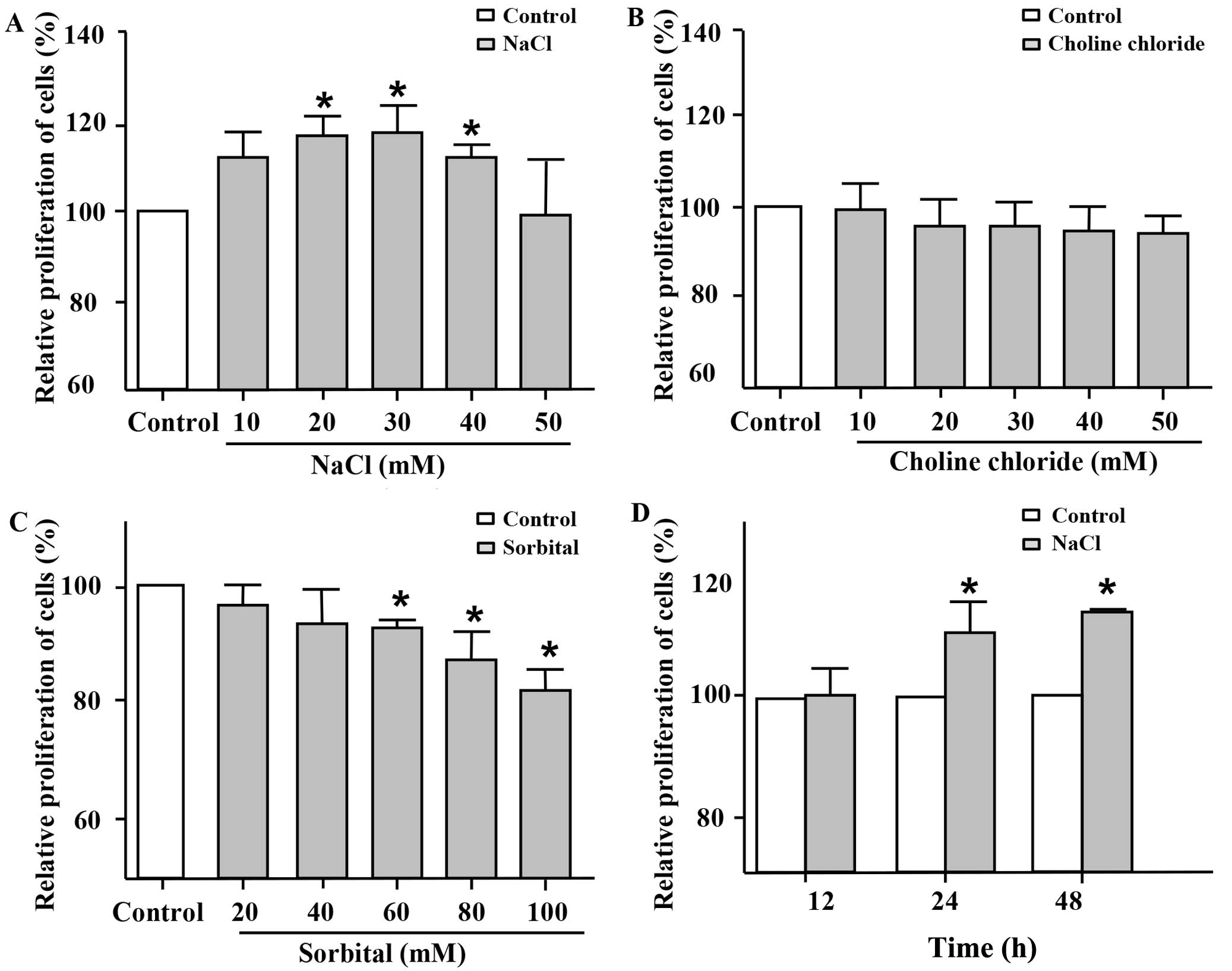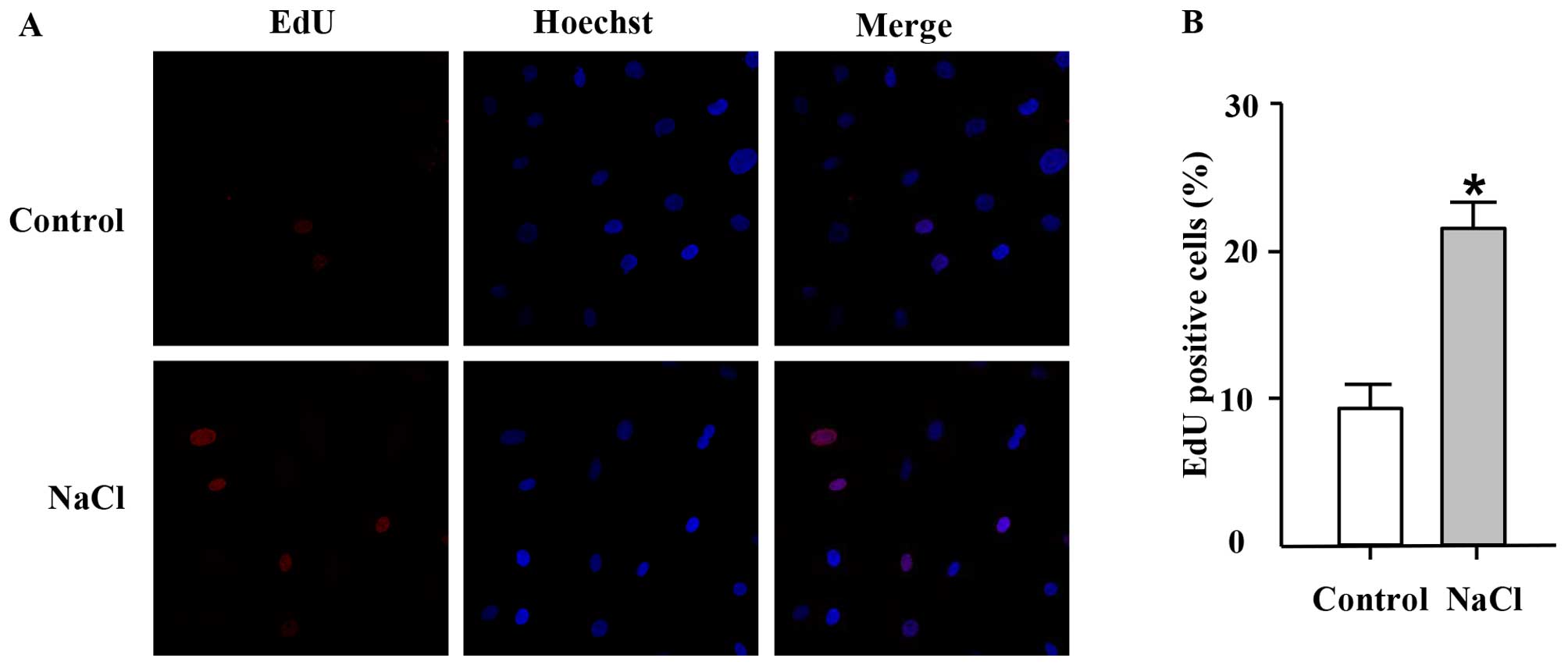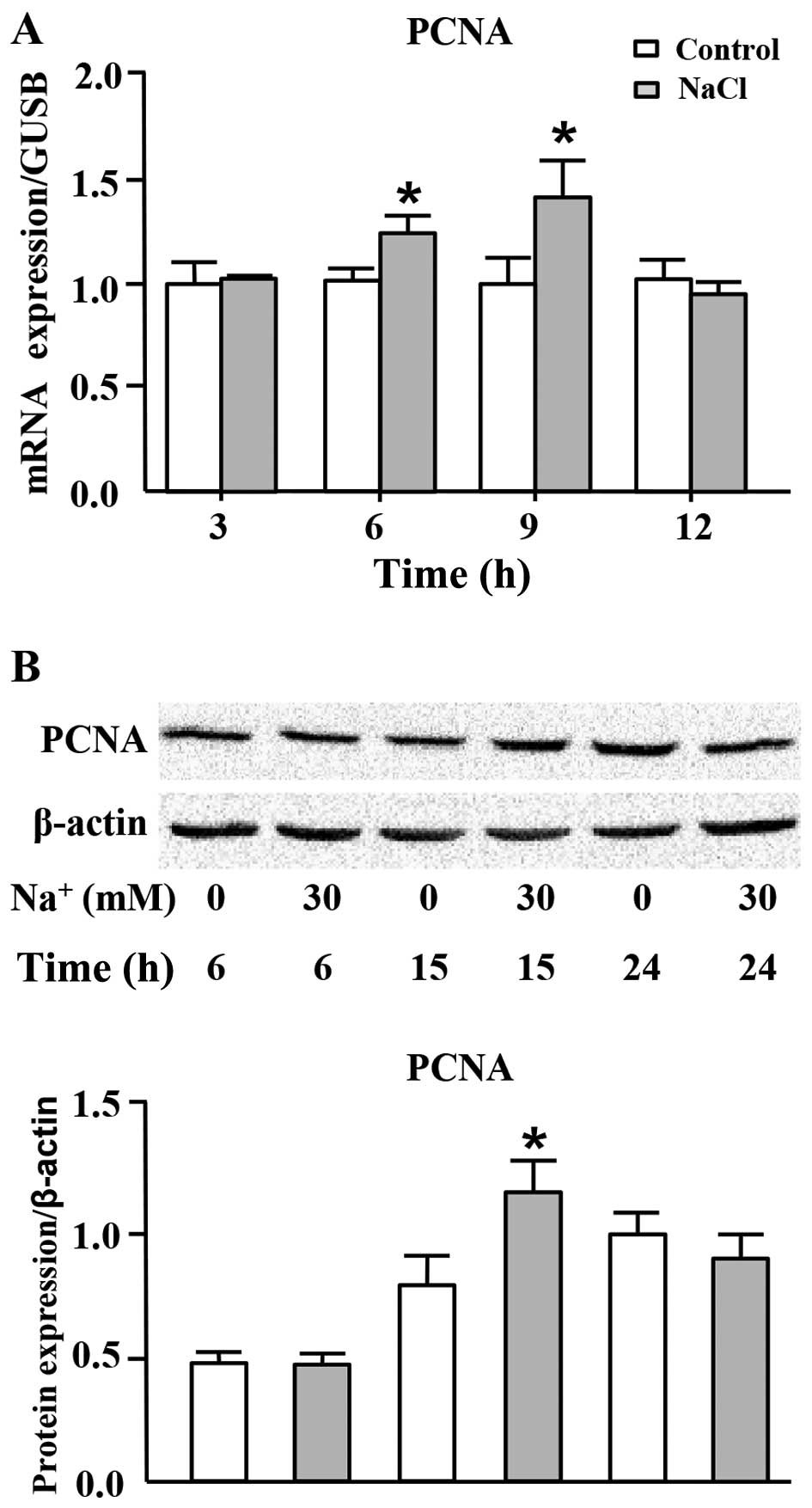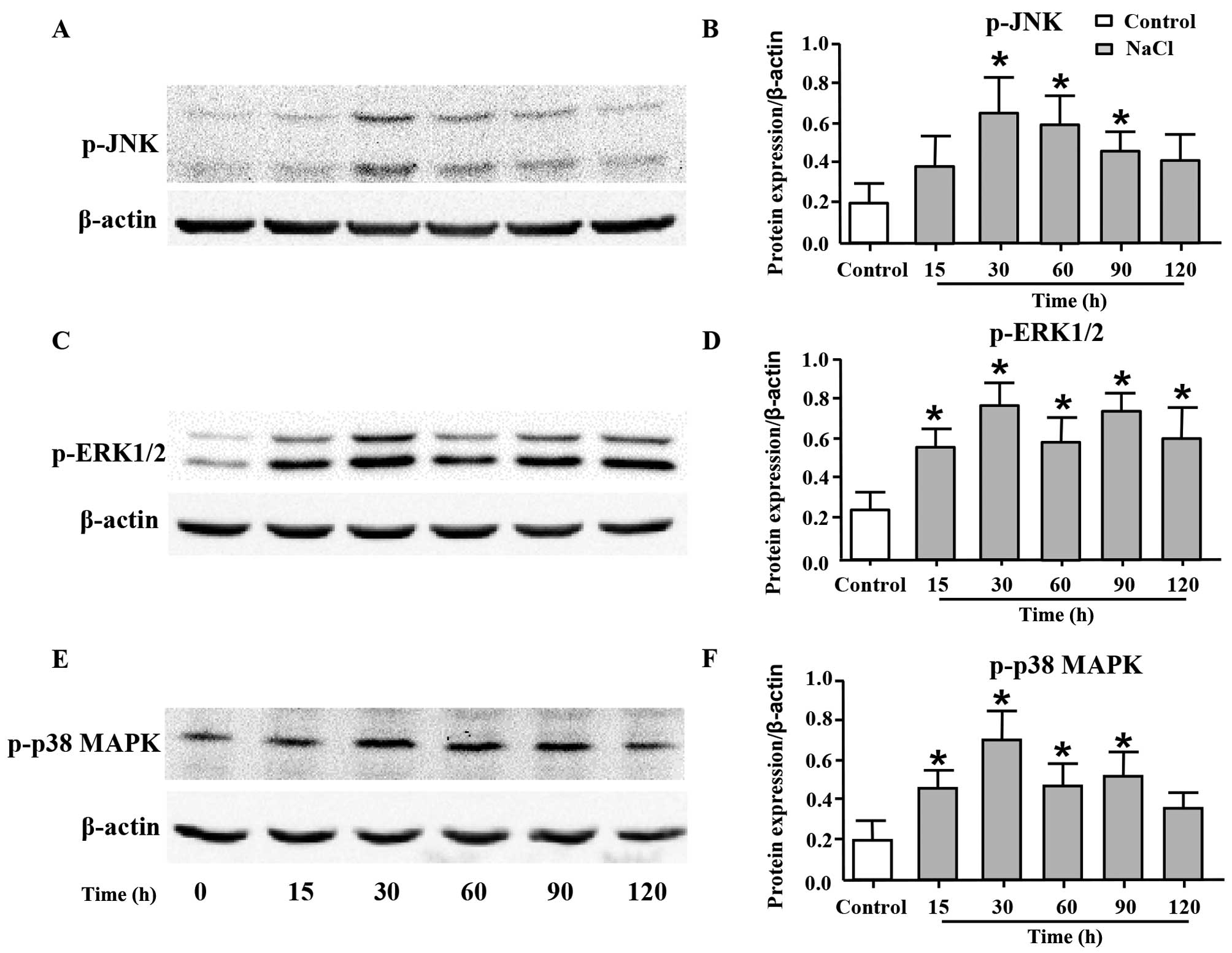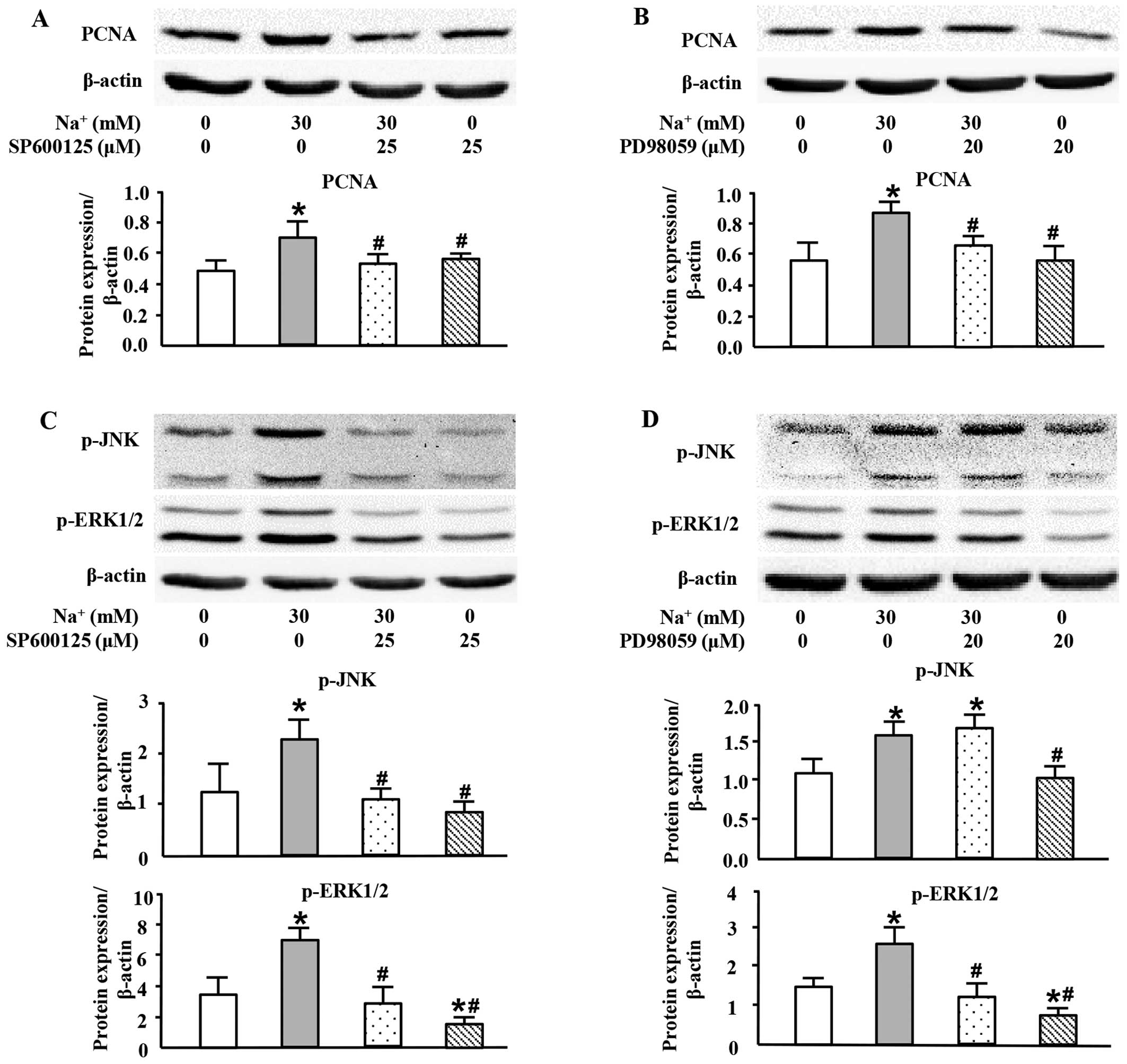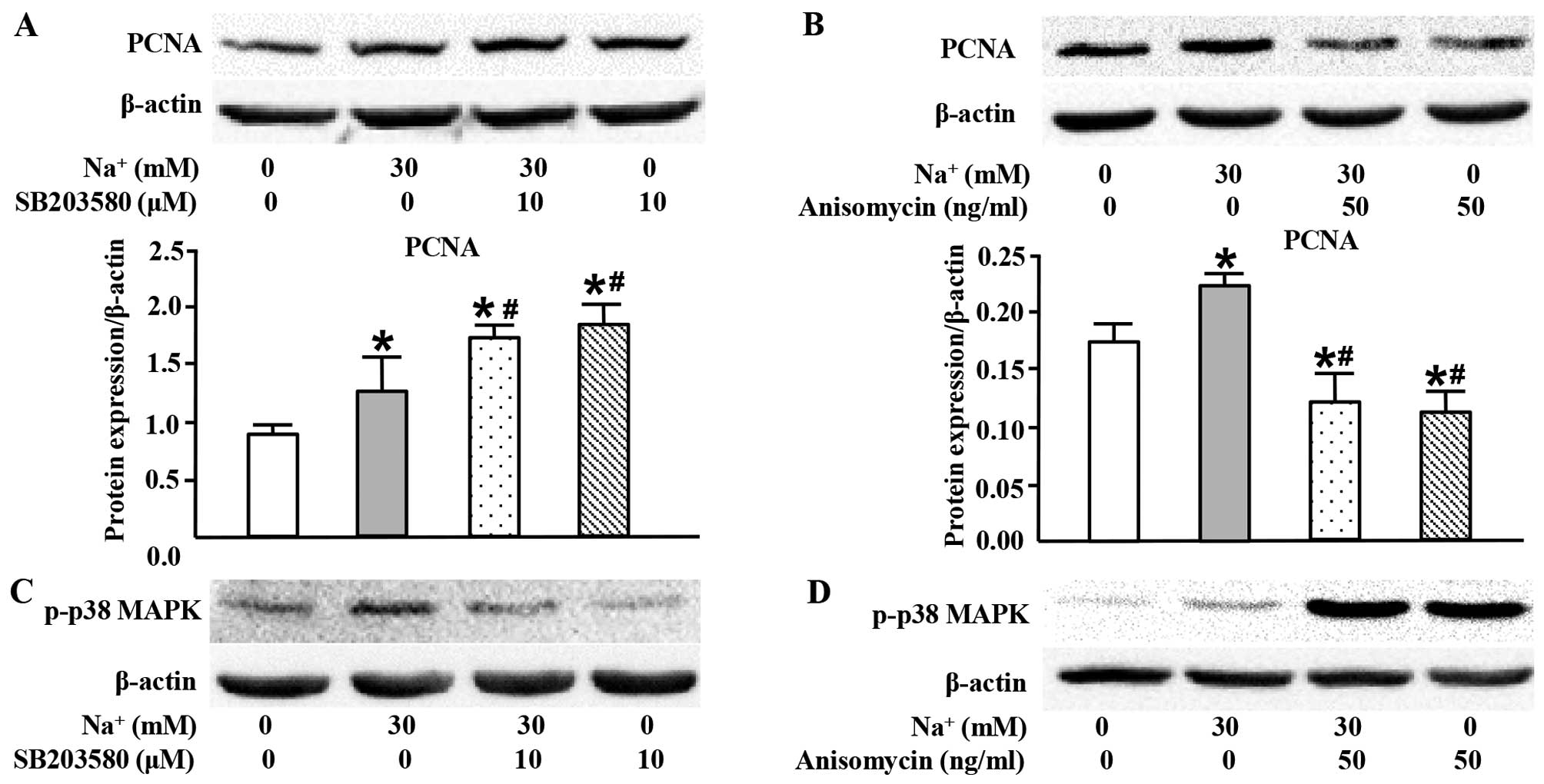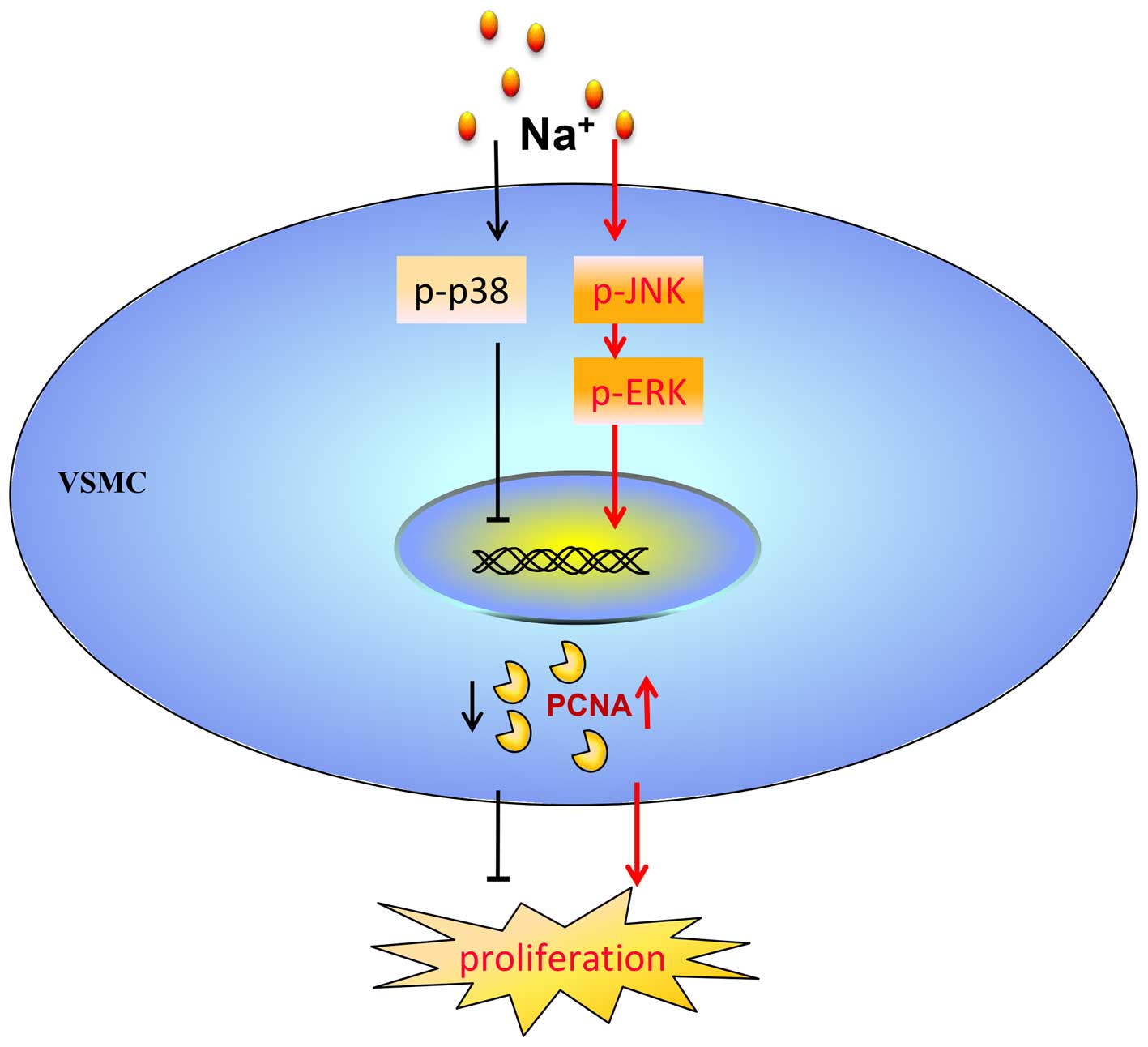The activation of p38 MAPK limits the abnormal proliferation of vascular smooth muscle cells induced by high sodium concentrations
- Authors:
- Published online on: October 27, 2015 https://doi.org/10.3892/ijmm.2015.2394
- Pages: 74-82
-
Copyright: © Wu et al. This is an open access article distributed under the terms of Creative Commons Attribution License.
Abstract
Introduction
As the principal cation in extracellular fluid, sodium (Na+) is an essential nutrient for the maintenance of normal cell function. However, a high-sodium diet (HSD) has been widely be implicated in the development of hypertension (1–3) and cardiovascular diseases, particularly fatal coronary heart diseases (1,4) and stroke (1).
Under physiological conditions, cells, such as inner medullary collecting duct (IMCD) cells of the collecting duct and vascular smooth muscle cells (VSMCs) of renal capillaries in the renal medulla, are normally exposed to variably high concentrations of urea and sodium chloride (NaCl), as a consequence of the urine concentrating mechanism (5). Under antidiuretic conditions, NaCl and urea are the most prevalent solutes in the medullary interstitium (6). In vitro studies have reported that when IMCD3 cells are exposed to culture medium to which extreme high concentrations of NaCl are added, this may lead to DNA damage (212.5 mM NaCl added) (7), oxidative stress (300 mM NaCl added) (8) and cell cycle arrest (100 mM NaCl added) (9). Therefore, the mechanisms responsible for the adaptation of cells such as IMCD3 and VSMCs to various concentrations of Na+ remain poorly understood and thus warrant further investigations.
Apart from the renal medulla, the interstitium containing large amounts of glycosaminoglycans is considered to be a separately regulated space for Na+ homeostasis (10,11). Long-term balance studies on humans have confirmed that considerable amounts of Na+ accumulate in the interstitium due to excessive NaCl consumption (12–14). The skin Na+ concentration due to HSD can be as high as 180 to 190 mM in rats (15). The study by Machnik et al further demonstrated that the interstitial accumulation of Na+ in skin results in hyperplasia of the lymph capillary network (10). Therefore, apart from physiological conditions in the renal medulla, it is necessary to further address whether HSD can lead to excess Na+ accumulation in different tissues and whether this Na+ retention may be associated with any adverse effects.
It should be noted that salt restriction further improves blood pressure control in patients treated with a combination of an angiotensin-converting enzyme (ACE) inhibitor and a diuretic (16). Matsushita et al also found that the combination of HSD with bilateral oophorectomy significantly increased the body Na+/water ratio, and increased cerebral aneurysm formation irrespective of hypertension (17). The abnormal proliferation of VSMCs is considered responsible for the physiological and pathophysiological changes taking place in the vascular wall (18,19). In this study, we aimed to assess whether Na+ per se directly affects the proliferation of VSMCs at relatively higher concentrations and to elucidate the underlying mechanisms. This may firstly shed light on the mechanisms responsible for the adaptation of VSMCs to high concentrations of Na+, and secondly, it may reveal the possible direct pathogenic effect of the excessive consumption of Na+, which is independent of pressure, the renin-angiotensin-aldosterone system (RAAS) (20,21) and endothelial function (22).
Materials and methods
Reagents, kits and antibodies
Dulbecco's modified Eagle's medium (DMEM)/high glucose and phenol red-free DMEM were purchased from HyClone (Logan, UT, USA). Charcoal stripped fetal bovine serum (FBS) was obtained from Gibco-BRL (Grand Island, NY, USA). Rabbit monoclonal antibodies against proliferating cell nuclear antigen (PCNA; 1:1,000; #13110), phosphorylated c-Jun amino N-terminal kinases (p-JNK; 1:1,000; #4668) and phosphorylated extracellular signal-regulated kinase 1/2 (p-ERK1/2; 1:2,000; #4370) were provided by Cell Signaling Technology (Beverly, MA, USA). Rabbit polyclonal antibody against phosphorylated p38 mitogen-activated protein kinase (p-p38 MAPK) was supplied by Signalway Antibody LLC (College Park, MD, USA). Rabbit monoclonal antibody against β-actin (1:10,000; JC-PA-βA1) and horseradish peroxidase-conjugated goat-anti-rabbit antibody (1:4,000; JC-PC012-1h) were purchased from Geneshare (Xi'an, Shannxi, China). NaCl, choline chloride, sorbital, mouse monoclonal anti-actin, α-smooth muscle-FITC antibody (anti-α-SM-actin antibody; F3777) and DAPI were obtained from Sigma-Aldrich (St. Louis, MO, USA). The Cell-Light™ 5-ethynyl-2′-deoxyuridine (EdU) imaging detecting kit was purchased from RiboBio (Guangzhou, China). SP600125 (a JNK inhibitor) was provided by Cell Signaling Technology. PD98059 (an ERK1/2 inhibitor), SB203580 (a p38 MAPK inhibitor) and anisomycin (a p38 MAPK activator) were supplied from Santa Cruz Biotechnology (Dallas, TX, USA). In addition, 3-(4,5-dimethylthiazol-2-yl)-2,5-diphenyltet-razolium bromide (MTT) was purchased from Amresco (Solon, OH, USA).
Cell culture and treatment
Rat VSMCs were purchased from CHI Scientific, Inc. (Jiangsu, China) and cultured in DMEM supplemented with 10% FBS at 37°C under 5% CO2/95% air in a humidified incubator. Cells at passages 3 to 8 with a purity of >95% (determined by immunofluorescence staining for α-SM-actin) were used in the experiments. In order to obtain quiescent VSMCs, the cells were incubated in serum-free medium for 24 h. Subsequently, standard DMEM supplemented with 5% FBS was used as the control culture medium, in which the Na+ concentration was approximately 156 mM. High-sodium medium was prepared by the addition of NaCl (10, 20, 30, 40 and 50 mM,respectively; additional to the levels already present in the medium) to the control culture medium. Choline chloride and sorbital were used to examine the effects of chloridion (Cl−) and osmotic pressure on the proliferation of the VSMCs. High-Cl− medium was prepared by the addition of choline chloride (10, 20, 30, and 50 mM, respectively; additional to the levels already present in the medium) to the control culture medium. High-osmotic pressure medium was prepared by the addition of sorbital (20, 40, 60, 80 and 100 mM, respectively; additional to the levels already present in the medium) to the control culture medium. For MTT assay, the VSMCs were treated for 12, 24 or 48 h. For EdU incorporation assay, the VSMCs were treated for 24 h. PCNA expression at the mRNA level was detected following treatment for 3, 6, 9 and 12 h. PCNA expression at the protein level was detected following treatment for 6, 15, or 24 h. Phosphorylation levels were detected after 15, 30, 60, 90 and 120 min of intervention. To examine the effects of 3 MAPK members on the proliferation of VSMCs induced by additional NaCl, the cells were pre-treated wtih SP600125 (a JNK inhibitor), PD98059 (an ERK1/2 inhibitor), SB203580 (a p38 MAPK inhibitor) and anisomycin (a p38 MAPK activator) for 30 min.
Immunofluorescence staining
The VSMCs were cultured on sterile glass cover slips in 12-well plates. Following fixation with 4% paraformaldehyde, the VSMCs were permeabilized by 0.1% Triton X-100 for 30 min at room temperature and blocked with goat serum for 1 h at 37°C. The cells then covered with anti-α-SM-actin antibody were incubated at 4°C in a dark humidified chamber overnight. The samples were counter-stained with DAPI at room temperature for 10 min. The images were captured using NIS-Elements imaging software (Nikon, Tokyo, Japan).
MTT assay
Cell proliferation was firstly investigated by MTT assay according to published literature (23). Briefly, the VSMCs were treated with additional NaCl (10–50 mM), choline chloride (10–50 mM) or sorbital (20–100 mM) in DMEM supplemented with 5% FBS for 12, 24 or 48 h. The cells were then incubated with MTT solution (0.1 mg/ml) for 4 h. The formed formazan crystals were dissolved in 150 μl/well dimethyl sulfoxide (DMSO). The absorbance was recorded at a wavelength of 490 nm using a microplate reader (Bio-Rad, Hercules, CA, USA). All experiments were performed at least 3 times. The relative proliferation of the cells was calculated as the absorbance of treated cells/control cells ×100%.
EdU incorporation assay
Following synchronization with serum-free medium for 24 h, the cells were treated with or without additional NaCl (30 mM) in DMEM supplemented with 5% FBS for 24 h. The EdU incorporation assay was performed according to the manufacturer's instructions (RiboBio). In brief, the VSMCs were incubated with 50 μM EdU for 2 h. Following fixation with 4% paraformaldehyde and permeabilization in 1.0% Triton X-100, the cells underwent EdU staining. The cell nuclei were counterstained with Hoechst 33342. EdU-positive nuclei were determined under a fluorescence microscope (Olympus BX51; Olympus, Tokyo, Japan). The cell proliferation rate was calculated as the proportion of nucleated cells incorporating EdU in 5 high-power fields per well.
RNA extraction and reverse transcription-quantitative polymerase chain reaction (RT-qPCR)
Quantification was carried out as previously described (24). Briefly, total RNA was extracted from the cells using TRIzol reagent and reverse transcribed using the cDNA synthesis kit (Fermentas, Burlington, CA, USA). Quantitative (real-time) PCR (qPCR) was performed using SYBR® select Master Mix on an iQ5 Multicolor Real-Time PCR Detection system (Bio-Rad). The primer sequences used for PCNA were as follows: sense, 5′-ACCTCACCAGC ATGTCCAA-3′ and antisense, 5′-CATAGTCTGAAACTTTC TCTTGATTTG-3′. Beta-glucuronidase (GUSB) was used as a housekeeping gene and the primer sequences were: sense, 5′-CTCTGGTGGCCTTACCTGAT-3′ and antisense, 5′-CAGA CTCAGGTGTTGTCA TCG-3′. The relative expression level of the target gene was then determined using a comparative method (2−ΔΔCT).
Western blot analysis
Western blot analysis was performed as previously described (24). Briefly, the VSMCs were lysed in RIPA buffer supplemented with protease and phosphatase inhibitors. The protein content was determined using a BCA protein assay kit (Pierce, Rockford, IL, USA). Equivalent amounts of protein were subjected to 10% sodium dodecyl sulfate-polyacrylamide gel electrophoresis (SDS-PAGE) for electrophoresis and then transferred onto PVDF membranes (Bio-Rad). The blots were incubated with primary antibodies against PCNA, p-JNK, p-ERK1/2, p-p38 MAPK and β-actin, and then with horseradish peroxidase-conjugated goat-anti-rabbit antibody. The protein signals were detected using chemiluminescence. All densitometric data for the target genes were corrected with β-actin as a loading control.
Statistical analysis
Data are expressed as the means ± standard deviation (SD). Comparisons among 3 or more groups were analyzed by one-way analysis of variance (ANOVA), whereas the Student's t-test was used for comparisons between 2 groups. A value of P<0.05 was considered to indicate a statistically significant difference. Statistical analysis was performed using SPSS 16.0 software (SPSS, Inc., Chicago, IL, USA).
Results
High sodium levels rather than high Cl− levels or osmotic pressure promote the proliferation of VSMCs
In the present study, we used α-SM-actin as a marker of contractile VSMCs to identify the phenotype and purity of the commercially available VSMCs (25). The cultured VSMCs exhibited a spindle-like shape. Immunofluorescence staining revealed an abundance of green myonemes in the cytoplasm. The purity of the obtained cells was >95% (data not shown).
Additional NaCl was added to the basal medium in order to verify whether Na+ directly promotes the proliferation of VSMCs at higher concentrations. First, MTT assay was used to evaluate cell proliferation. Following incubation for 24 h, the addition of 20–40 mM NaCl to the cell medium markedly promoted the proliferation of the VSMCs compared with the untreated control group (Fig. 1A). Furthermore, this induction of cell proliferation by the high sodium levels was the most significant when 30 mM NaCl were added. To further clarify whether the proliferative effects of NaCl on VSMCs are due to Na+ itself, choline chloride and sorbital were also employed in the present study. Choline chloride at various concentrations, which was used as Cl− intervention, did not increase the proliferation of the VSMCs (Fig. 1B). Sorbital, which was used as osmotic intervention, exhibited no significant effect on the proliferation of the VSMCs (Fig. 1C) at low concentrations (20 and 40 mM). Indeed, sorbital inhibited the proliferation of the VSMCs when used at a concentration of >60 mM. As shown in Fig. 1D, the addition of NaCl (30 mM; additional to the levels already in medium) to the cell medium promoted the proliferation of the VSMCs following incubation for 24 and 48 h, but not for 12 h. These results indicated that Na+ at relatively high concentrations per se, rather than Cl− or osmotic pressure promoted the proliferation of VSMCs.
EdU, a thymidine analogue, is incorporated into cellular DNA during cell proliferation (26). Thus, in this study, we used the EdU incorporation assay to further confirm the effects of high sodium levels on the proliferation of VSMCs. In accordance with the results of MTT assay, EdU incorporation assay revealed that addition of NaCl (30 mM; additional to the levels already in medium) to the cell culture medium for 24 h increased the percentage of EdU-positive nuclei compared with the control group (Fig. 2), thus indicating an increase in DNA synthesis in the ultured VSMCs which was induced by NaCl.
High sodium level increases PCNA expression at both the mRNA and protein levels
PCNA, the eukaryotic DNA sliding clamp, confers high processivity to replicative DNA polymerase, which is recognized as a marker of cell proliferation (27,28). We thus measured the mRNA and protein expression levels of PCNA in the cells cultured in medium with the addition of high level of sodium. As shown in Fig. 3A, the mRNA expression of PCNA was significantly increased following the addition of 30 mM Na+ to the cell culture medium (additional to the levels already in medium) for 6 and 9 h. In addition, the protein expression of PCNA was transiently, but markedly increased following the addition of Na+ to the medium for 15 h (Fig. 3B).
High sodium level increases the phosphorylation levels of JNK, ERK1/2 and p38 MAPK
JNK, ERK1/2 and p38 MAPK are the members of MAPK family, and they play important roles in cell proliferation (29,30). Thus, in order to elucidate the underlying mechanisms responsible for the proliferative effects of additional Na+ on VSMCs, we measured the phosphorylation levels of JNK, ERK1/2 and p38 MAPK by western blot analysis. As shown in Fig. 4, the expression levels of p-JNK (Fig. 4A and B), p-ERK1/2 (Fig. 4C and D) and p-p38 MAPK (Fig. 4E and F) were significantly increased following the addition of 30 mM Na+ to the cell culture medium (additional to the levels already in medium) for 30 min, and such an increase was maintained until 120 min post-treatment.
High sodium level increases PCNA expression at the protein level through the JNK/ERK1/2 pathway
To further investigate the exact roles of MAPK members in the high-sodium induced proliferation of VSMCs, specific inhibitors of JNK and ERK1/2 were used in this study. As shown in Fig. 5, both SP600125, a JNK inhibitor (Fig. 5A), and PD98059, an ERK1/2 inhibitor (Fig. 5B), almost completely inhibited PCNA expression induced by the addition of Na+ (30 mM; additional to the levels already in medium). The JNK inhibitor, SP600125, also decreased the expression of p-ERK1/2 which was induced by the addition of Na+ (30 mM; additional to the levels already in medium) (Fig. 5C). However, the ERK1/2 inhibitor, PD98059, did not significantly affect the phosphorylation level of JNK (Fig. 5D). These results indicated that high sodium levels induced the expression of PCNA through JNK/ERK1/2 pathway, and that JNK was located upstream of ERK1/2.
High sodium level simultaneously inhibits PCNA expression through p38 MAPK
In the present study, we also used SB203580 (a p38 MAPK inhibitor) in order to examine the role of p38 MAPK in the high-sodium induced proliferation of VSMCs. Surprisingly, SB203580 markedly increased PCNA expression at the protein level (Fig. 6A). Conversely, anisomycin, the activator of p38 MAPK, inhibited PCNA expression (Fig. 6B). These results suggested that activated p38 MAPK played an opposite role to JNK and ERK1/2 in the high-sodium induced proliferation of VSMCs.
Discussion
As the major risk factor for cardiovascular diseases (1–4,31), increasing attention has been paid to the physiological and pathophysiological effects of excess Na+ consumption. The present study demonstrated two major findings: i) Additional Na+ per se increased the proliferation of VSMCs weakly (10%), but directly at relatively higher concentrations; ii) the addition of Na+ activated the JNK/ERK1/2/PCNA pathway to promote the proliferation of VSMCs, and this abnormal proliferative effect was limited by simultaneously activated p38 MAPK.
In the present study, we mainly focused on the direct effects of additional NaCl on the proliferation of VSMCs to avoid the confounding impact from other factors, as shown in in vivo studies, such as RAAS (20,21), endothelial function (22) and ouabain (32). We demonstrated that additional Na+ itself directly increased the proliferation of VSMCs at a concentration ranging from 20 to 40 mM (Figs. 1Figure 2–3). Since the basic culture medium of VSMCs is DMEM, in which the Na+ concentration is approximately 156 mM, the final Na+ concentrations thus ranged from 176 to 196 mM in the present study. This level of Na+ concentration could appear both in the renal medulla under physiological conditions (5) and in the skin interstitium due to HSD (10). Although Na+ increased the proliferation of VSMCs by only approximately 10% compared with the control group, and this effect is not as prominent as that of other factors, such as angiotensin II (20), its proliferative effects were still significant since i) the proliferation of the VSMCs was maintained at a low level when the cells were exposed to relatively higher concentrations of Na+. This interesting response of VSMCs to high concentrations of Na+ may indicate a possible mechanism which plays a role in the adaptation of tissues exposed to fluctuant concentrations of Na+ in the renal medulla; ii) aside from the increase in blood pressure, the activation of RAAS and endothelial dysfunction, the increase in the proliferation of the VSMCs by 10% induced by the interstitial Na+ accumulation itself can still be considered as an important pathogenic factor for hypertension, cardiovascular disease and stroke; iii) as previously described by Singer et al (16), medication against RAAS and other possible treatments cannot solve all the health issues and sodium restriction itself is a simple, but significant prevention or even therapeutic approach.
As an extracellular stimuli, it has been proven that NaCl can affect MAPKs in several cell types, such as endothelial cells (33), monocytes (34) and HEK293 cells (35). For cell cycle progression, it is considered that the activation of JNK and ERK1/2 can accelerate cell proliferation (36,37), whereas p38 MAPK plays an opposite role (38–40). In the present study, Na+ increased the phosphorylation of JNK (Fig. 4A) and ERK1/2 (Fig. 4C) and increased PCNA expression (Fig. 5), and these results were consistent with those of the above-mentioned studies. Moreover, p38 MAPK was phosphorylated (Fig. 4E) at the same time, but played an opposite role (Fig. 6). Since Na+ is an essential nutrient for normal cell function, the findings of our study indicate that high sodium levels may simultaneously activate p38 MAPK, a negative regulatory mechanism, in order to limit abnormal proliferation, maintaining cell proliferation at a relatively low level.
There were several limitations to the present study as follows: i) in spite of the abundance of existing connective tissue, to the best of our knowledge, no studies to date have demonstrated the exact amount of Na+ which is accumulated in the vascular wall. Therefore, it is necessary to develop a novel, but feasible method with which to determine the accumulation of Na+ and measure its exact concentrations in the vascular walls due to HSD; ii) the detailed mechanisms and the cross- talk between JNK, ERK1/2 and p38 MAPK warrants further investigations.
In conclusion, the findings of this study demonstrated that additional Na+ per se directly promoted the proliferation of VSMCs through the JNK/ERK1/2/PCNA pathway. At the same time, the proliferation of the VSMCs which was induced by additional Na+ was maintained at a low level via the activation of p38 MAPK (Fig. 7).
Acknowledgments
This study was financially supported by the National Natural Science Fund (nos. 91339116 and 81102843) and the National Basic Research Program of China ('973 Project' no. 2012CB517804).
References
|
Aburto NJ, Ziolkovska A, Hooper L, Elliott P, Cappuccio FP and Meerpohl JJ: Effect of lower sodium intake on health: Systematic review and meta-analyses. BMJ. 346:f13262013. View Article : Google Scholar : PubMed/NCBI | |
|
Graudal NA, Hubeck-Graudal T and Jürgens G: Effects of low-sodium diet vs. high-sodium diet on blood pressure, renin, aldosterone, catecholamines, cholesterol, and triglyceride (Cochrane Review). Am J Hypertens. 25:1–15. 2012. View Article : Google Scholar | |
|
He FJ, Li J and Macgregor GA: Effect of longer term modest salt reduction on blood pressure: Cochrane systematic review and meta-analysis of randomised trials. BMJ. 346:f13252013. View Article : Google Scholar : PubMed/NCBI | |
|
Taylor RS, Ashton KE, Moxham T, Hooper L and Ebrahim S: Reduced dietary salt for the prevention of cardiovascular disease: A meta-analysis of randomized controlled trials (Cochrane review). Am J Hypertens. 24:843–853. 2011. View Article : Google Scholar : PubMed/NCBI | |
|
Neuhofer W and Beck FX: Cell survival in the hostile environment of the renal medulla. Annu Rev Physiol. 67:531–555. 2005. View Article : Google Scholar : PubMed/NCBI | |
|
Cha JH, Woo SK, Han KH, Kim YH, Handler JS, Kim J and Kwon HM: Hydration status affects nuclear distribution of transcription factor tonicity responsive enhancer binding protein in rat kidney. J Am Soc Nephrol. 12:2221–2230. 2001.PubMed/NCBI | |
|
Kültz D and Chakravarty D: Hyperosmolality in the form of elevated NaCl but not urea causes DNA damage in murine kidney cells. Proc Natl Acad Sci USA. 98:1999–2004. 2001. View Article : Google Scholar : PubMed/NCBI | |
|
Zhang Z, Dmitrieva NI, Park JH, Levine RL and Burg MB: High urea and NaCl carbonylate proteins in renal cells in culture and in vivo, and high urea causes 8-oxoguanine lesions in their DNA. Proc Natl Acad Sci USA. 101:9491–9496. 2004. View Article : Google Scholar : PubMed/NCBI | |
|
Santos BC, Chevaile A, Hébert MJ, Zagajeski J and Gullans SR: A combination of NaCl and urea enhances survival of IMCD cells to hyperosmolality. Am J Physiol. 274:F1167–F1173. 1998.PubMed/NCBI | |
|
Machnik A, Neuhofer W, Jantsch J, Dahlmann A, Tammela T, Machura K, Park JK, Beck FX, Müller DN, Derer W, et al: Macrophages regulate salt-dependent volume and blood pressure by a vascular endothelial growth factor-C-dependent buffering mechanism. Nat Med. 15:545–552. 2009. View Article : Google Scholar : PubMed/NCBI | |
|
Nijst P, Verbrugge FH, Grieten L, Dupont M, Steels P, Tang WH and Mullens W: The pathophysiological role of interstitial sodium in heart failure. J Am Coll Cardiol. 65:378–388. 2015. View Article : Google Scholar : PubMed/NCBI | |
|
Heer M, Baisch F, Kropp J, Gerzer R and Drummer C: High dietary sodium chloride consumption may not induce body fluid retention in humans. Am J Physiol Renal Physiol. 278:F585–F595. 2000.PubMed/NCBI | |
|
Kirkendall AM, Connor WE, Abboud F, Rastogi SP, Anderson TA and Fry M: The effect of dietary sodium chloride on blood pressure, body fluids, electrolytes, renal function, and serum lipids of normotensive man. J Lab Clin Med. 87:411–434. 1976.PubMed/NCBI | |
|
Palacios C, Wigertz K, Martin BR, Jackman L, Pratt JH, Peacock M, McCabe G and Weaver CM: Sodium retention in black and white female adolescents in response to salt intake. J Clin Endocrinol Metab. 89:1858–1863. 2004. View Article : Google Scholar : PubMed/NCBI | |
|
Titze J, Shakibaei M, Schafflhuber M, Schulze-Tanzil G, Porst M, Schwind KH, Dietsch P and Hilgers KF: Glycosaminoglycan polymerization may enable osmotically inactive Na+ storage in the skin. Am J Physiol Heart Circ Physiol. 287:H203–H208. 2004. View Article : Google Scholar : PubMed/NCBI | |
|
Singer DR, Markandu ND, Sugden AL, Miller MA and MacGregor GA: Sodium restriction in hypertensive patients treated with a converting enzyme inhibitor and a thiazide. Hypertension. 17:798–803. 1991. View Article : Google Scholar : PubMed/NCBI | |
|
Matsushita N, Kitazato KT, Tada Y, Sumiyoshi M, Shimada K, Yagi K, Kanematsu Y, Satomi J and Nagahiro S: Increase in body Na+/water ratio is associated with cerebral aneurysm formation in oophorectomized rats. Hypertension. 60:1309–1315. 2012. View Article : Google Scholar : PubMed/NCBI | |
|
Lacolley P, Regnault V, Nicoletti A, Li Z and Michel JB: The vascular smooth muscle cell in arterial pathology: A cell that can take on multiple roles. Cardiovasc Res. 95:194–204. 2012. View Article : Google Scholar : PubMed/NCBI | |
|
Shi N and Chen SY: Mechanisms simultaneously regulate smooth muscle proliferation and differentiation. J Biomed Res. 28:40–46. 2014. View Article : Google Scholar : PubMed/NCBI | |
|
Liu G, Hitomi H, Rahman A, Nakano D, Mori H, Masaki T, Ma H, Iwamoto T, Kobori H and Nishiyama A: High sodium augments angiotensin II-induced vascular smooth muscle cell proliferation through the ERK1/2-dependent pathway. Hypertens Res. 37:13–18. 2014. View Article : Google Scholar : | |
|
Makita S, Nakamura M, Yoshida H and Hiramori K: Effect of angiotensin II receptor blocker on angiotensin II stimulated DNA synthesis of cultured human aortic smooth muscle cells. Life Sci. 56:PL383–PL388. 1995. View Article : Google Scholar : PubMed/NCBI | |
|
Komuro I, Kurihara H, Sugiyama T, Yoshizumi M, Takaku F and Yazaki Y: Endothelin stimulates c-fos and c-myc expression and proliferation of vascular smooth muscle cells. FEBS Lett. 238:249–252. 1988. View Article : Google Scholar : PubMed/NCBI | |
|
Liu J, Ren Y, Kang L and Zhang L: Oxidized low-density lipoprotein increases the proliferation and migration of human coronary artery smooth muscle cells through the upregulation of osteopontin. Int J Mol Med. 33:1341–1347. 2014.PubMed/NCBI | |
|
Wang H, Liu Y, Zhu L, Wang W, Wan Z, Chen F, Wu Y, Zhou J and Yuan Z: 17β-estradiol promotes cholesterol efflux from vascular smooth muscle cells through a liver X receptor α-dependent pathway. Int J Mol Med. 33:550–558. 2014.PubMed/NCBI | |
|
Weissberg PL, Cary NR and Shanahan CM: Gene expression and vascular smooth muscle cell phenotype. Blood Press Suppl. 2:68–73. 1995.PubMed/NCBI | |
|
Salic A and Mitchison TJ: A chemical method for fast and sensitive detection of DNA synthesis in vivo. Proc Natl Acad Sci USA. 105:2415–2420. 2008. View Article : Google Scholar : PubMed/NCBI | |
|
Guzińska-Ustymowicz K, Pryczynicz A, Kemona A and Czyzewska J: Correlation between proliferation markers: PCNA, Ki-67, MCM-2 and antiapoptotic protein Bcl-2 in colorectal cancer. Anticancer Res. 29:3049–3052. 2009. | |
|
Liu D, Huang Y, Bu D, Liu AD, Holmberg L, Jia Y, Tang C, Du J and Jin H: Sulfur dioxide inhibits vascular smooth muscle cell proliferation via suppressing the Erk/MAP kinase pathway mediated by cAMP/PKA signaling. Cell Death Dis. 5:e12512014. View Article : Google Scholar : PubMed/NCBI | |
|
Boutros T, Chevet E and Metrakos P: Mitogen-activated protein (MAP) kinase/MAP kinase phosphatase regulation: Roles in cell growth, death, and cancer. Pharmacol Rev. 60:261–310. 2008. View Article : Google Scholar : PubMed/NCBI | |
|
Cargnello M and Roux PP: Activation and function of the MAPKs and their substrates, the MAPK-activated protein kinases. Microbiol Mol Biol Rev. 75:50–83. 2011. View Article : Google Scholar : PubMed/NCBI | |
|
Powles J, Fahimi S, Micha R, Khatibzadeh S, Shi P, Ezzati M, Engell RE, Lim SS, Danaei G, Mozaffarian D, et al Global Burden of Diseases Nutrition and Chronic Diseases Expert Group (NutriCoDE): Global, regional and national sodium intakes in 1990 and 2010: A systematic analysis of 24 h urinary sodium excretion and dietary surveys worldwide. BMJ Open. 3:e0037332013. View Article : Google Scholar : PubMed/NCBI | |
|
Blaustein MP, Leenen FHH, Chen L, Golovina VA, Hamlyn JM, Pallone TL, Van Huysse JW, Zhang J and Wier WG: How NaCl raises blood pressure: A new paradigm for the pathogenesis of salt-dependent hypertension. Am J Physiol Heart Circ Physiol. 302:H1031–H1049. 2012. View Article : Google Scholar : | |
|
Duzgun SA, Rasque H, Kito H, Azuma N, Li W, Basson MD, Gahtan V, Dudrick SJ and Sumpio BE: Mitogen-activated protein phosphorylation in endothelial cells exposed to hyperosmolar conditions. J Cell Biochem. 76:567–571. 2000. View Article : Google Scholar : PubMed/NCBI | |
|
Kleinewietfeld M, Manzel A, Titze J, Kvakan H, Yosef N, Linker RA, Muller DN and Hafler DA: Sodium chloride drives autoimmune disease by the induction of pathogenic TH17 cells. Nature. 496:518–522. 2013. View Article : Google Scholar : PubMed/NCBI | |
|
Zhou X, Ferraris JD, Dmitrieva NI, Liu Y and Burg MB: MKP-1 inhibits high NaCl-induced activation of p38 but does not inhibit the activation of TonEBP/OREBP: Opposite roles of p38alpha and p38delta. Proc Natl Acad Sci USA. 105:5620–5625. 2008. View Article : Google Scholar : PubMed/NCBI | |
|
Jaeschke A, Karasarides M, Ventura JJ, Ehrhardt A, Zhang C, Flavell RA, Shokat KM and Davis RJ: JNK2 is a positive regulator of the cJun transcription factor. Mol Cell. 23:899–911. 2006. View Article : Google Scholar : PubMed/NCBI | |
|
Meloche S and Pouysségur J: The ERK1/2 mitogen-activated protein kinase pathway as a master regulator of the G1- to S-phase transition. Oncogene. 26:3227–3239. 2007. View Article : Google Scholar : PubMed/NCBI | |
|
Cuadrado A and Nebreda AR: Mechanisms and functions of p38 MAPK signalling. Biochem J. 429:403–417. 2010. View Article : Google Scholar : PubMed/NCBI | |
|
Mikhailov A, Shinohara M and Rieder CL: The p38-mediated stress-activated checkpoint. A rapid response system for delaying progression through antephase and entry into mitosis. Cell Cycle. 4:57–62. 2005. View Article : Google Scholar | |
|
Perdiguero E, Ruiz-Bonilla V, Serrano AL and Muñoz-Cánoves P: Genetic deficiency of p38alpha reveals its critical role in myoblast cell cycle exit: The p38alpha-JNK connection. Cell Cycle. 6:1298–1303. 2007. View Article : Google Scholar : PubMed/NCBI |



